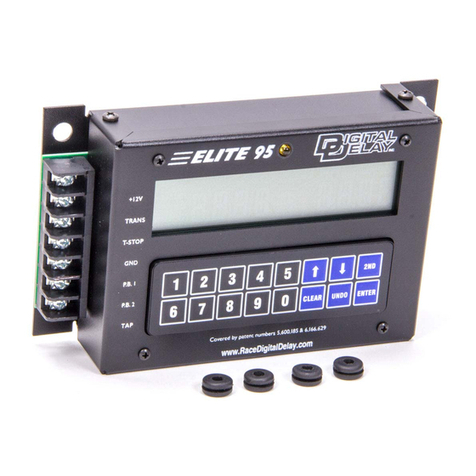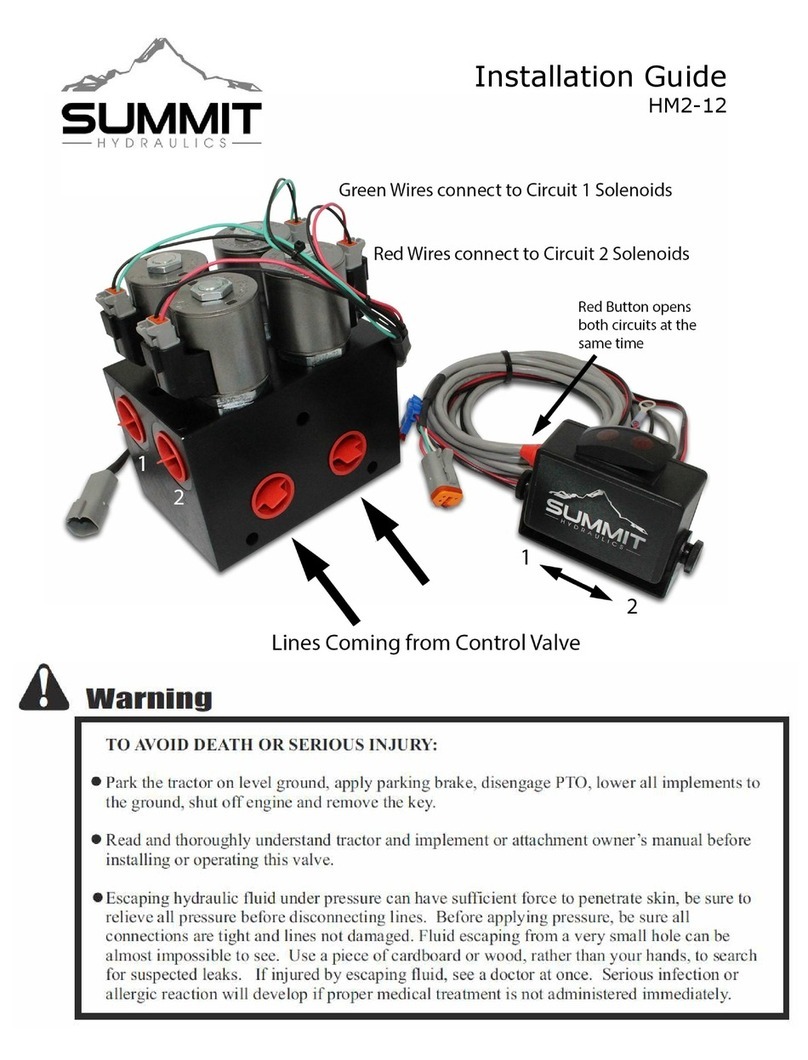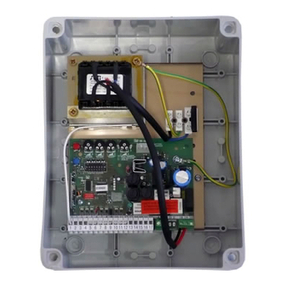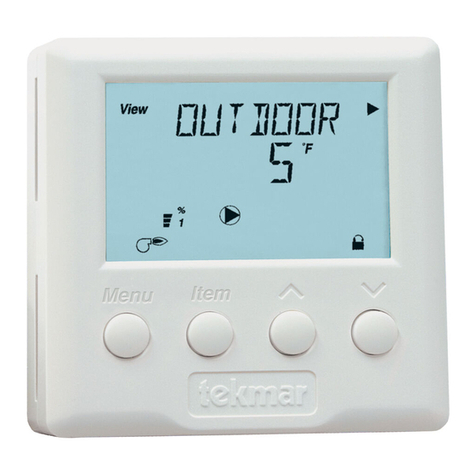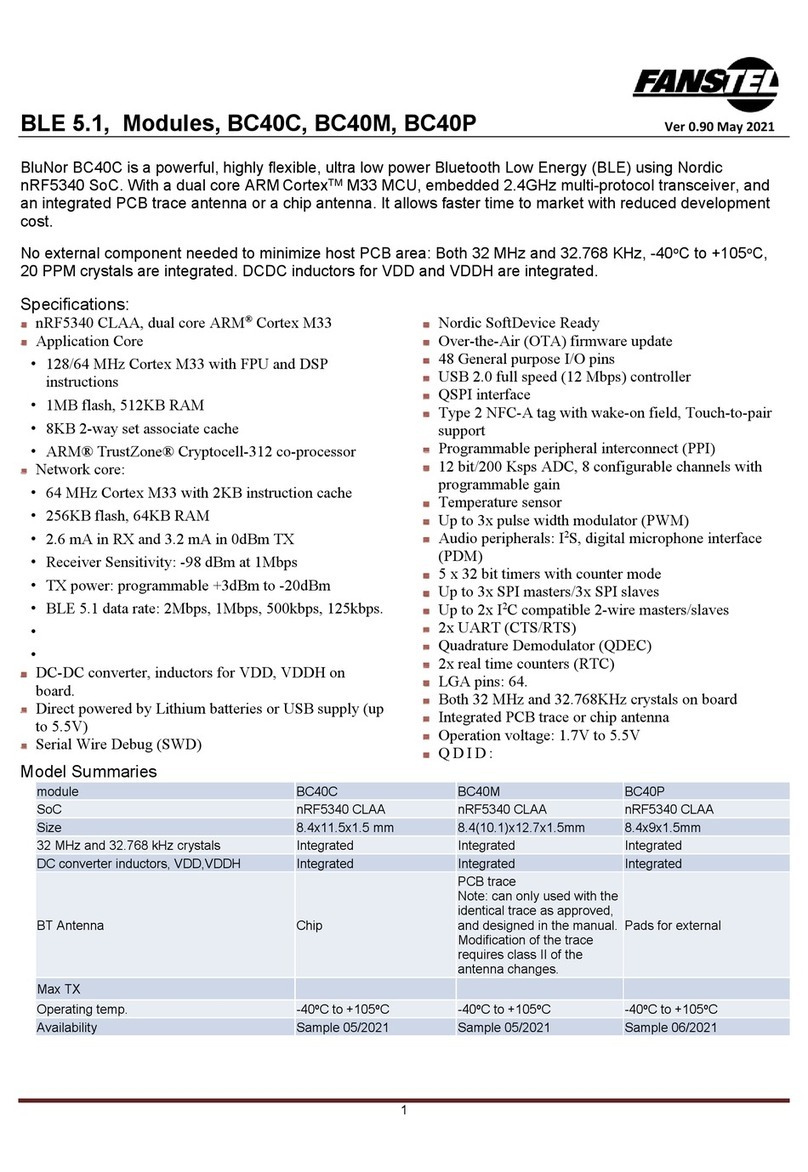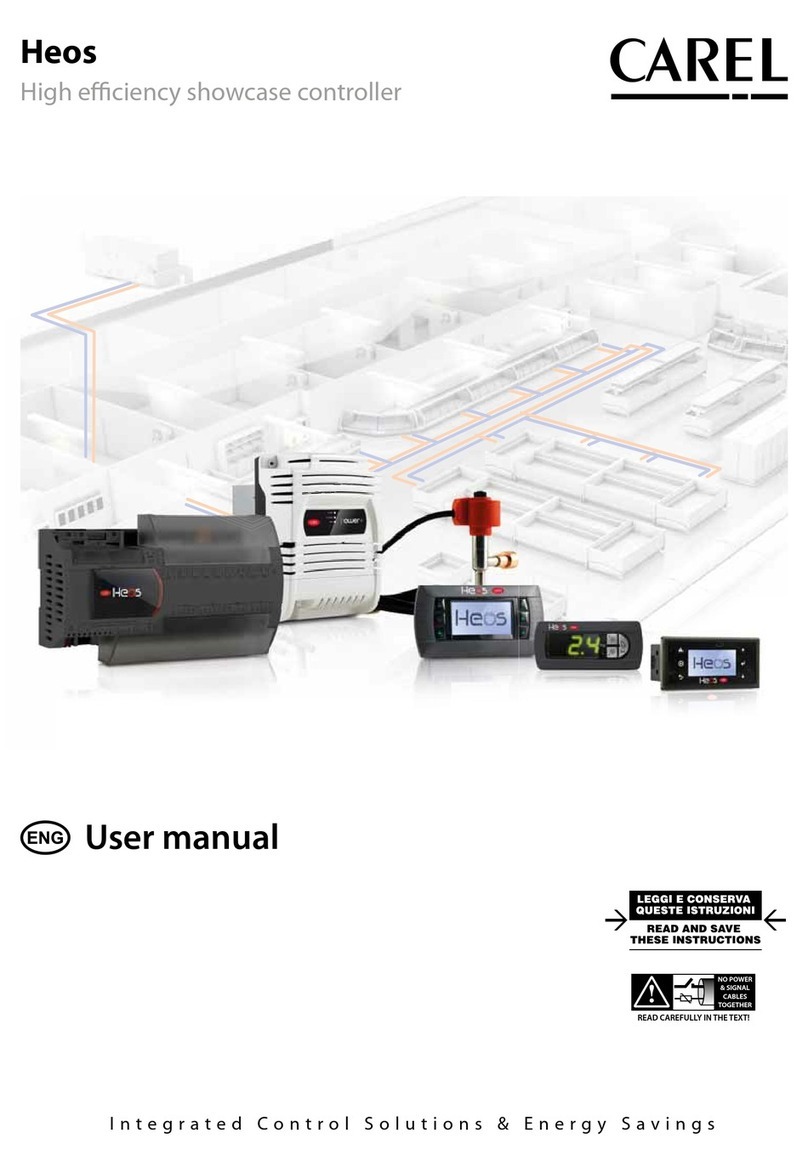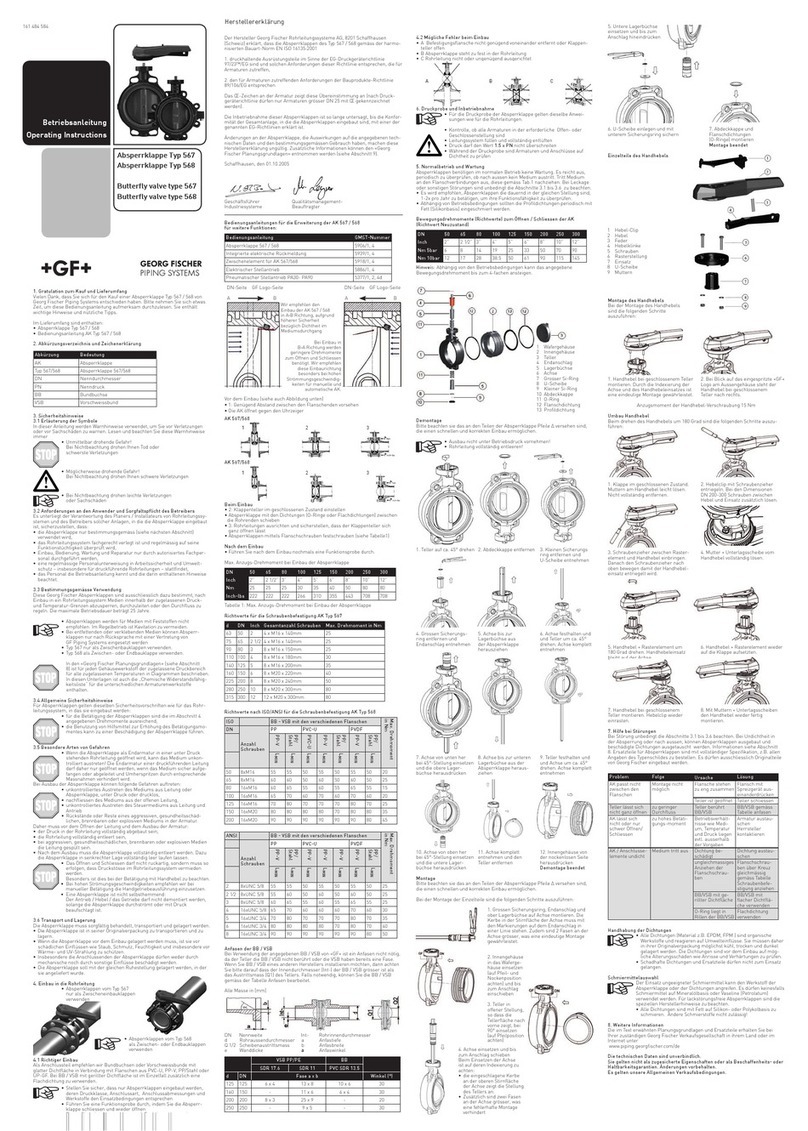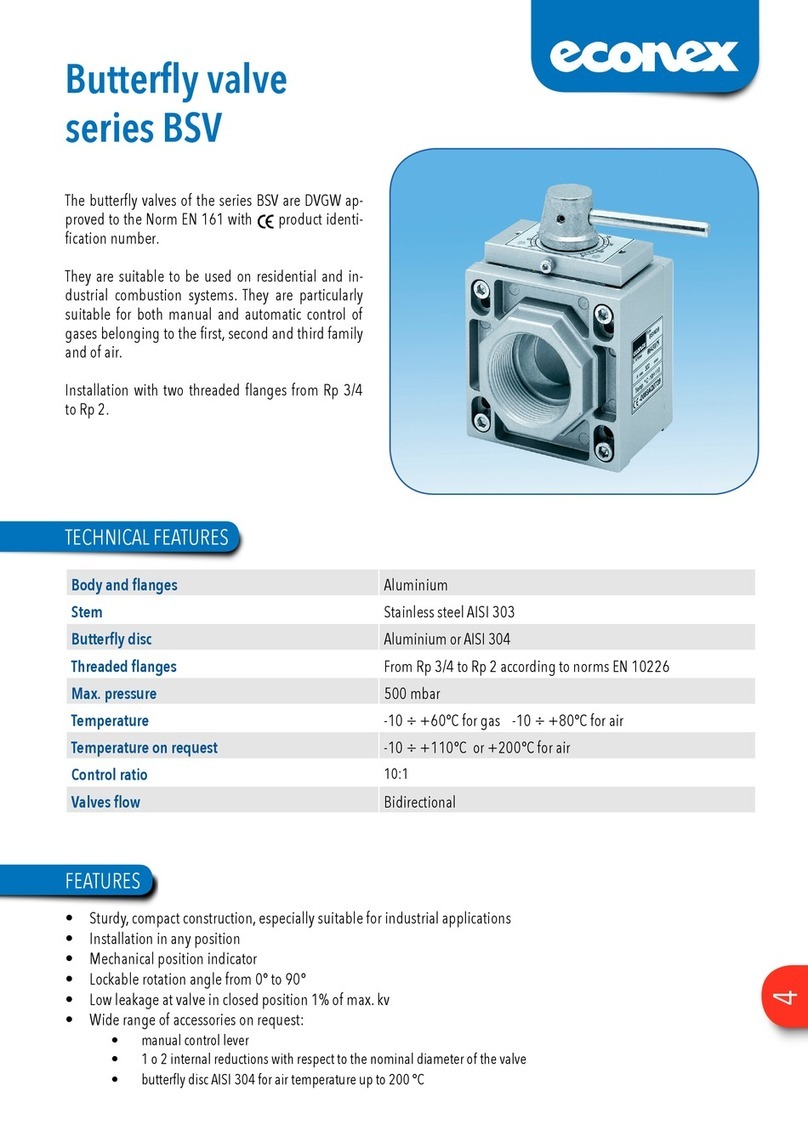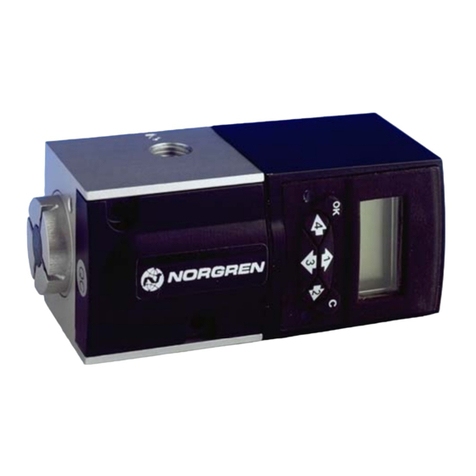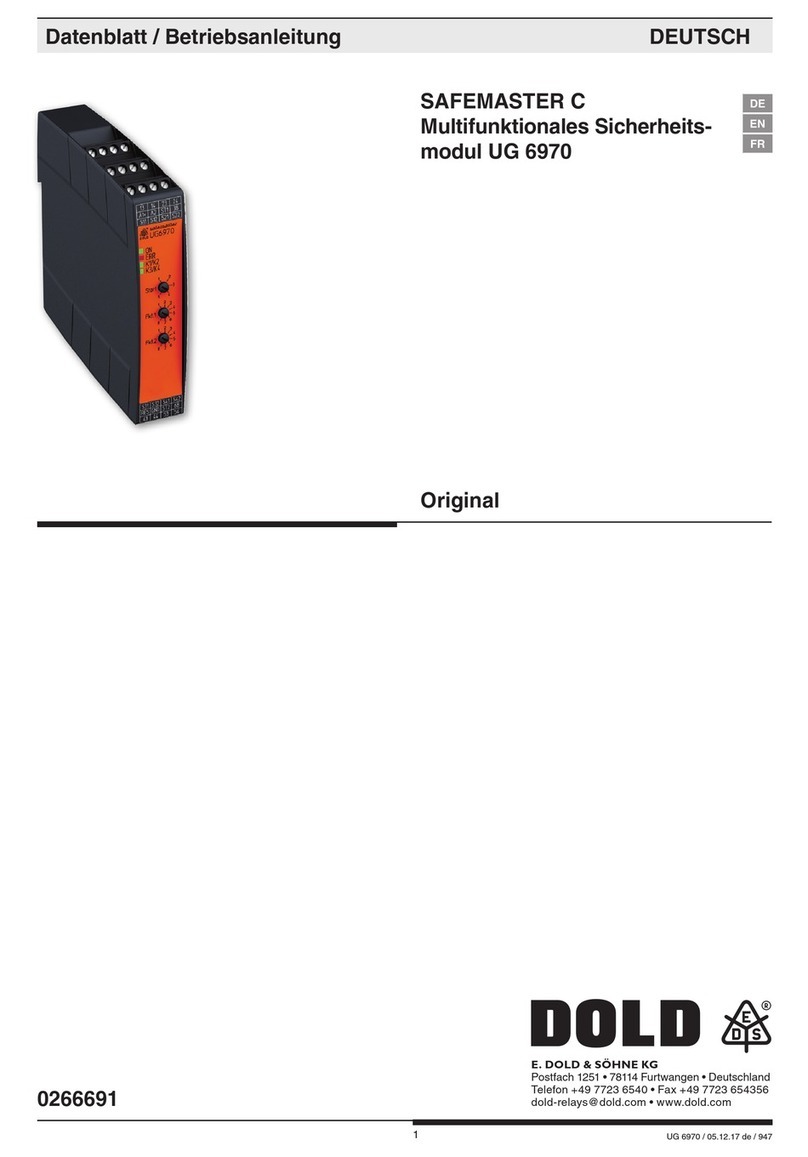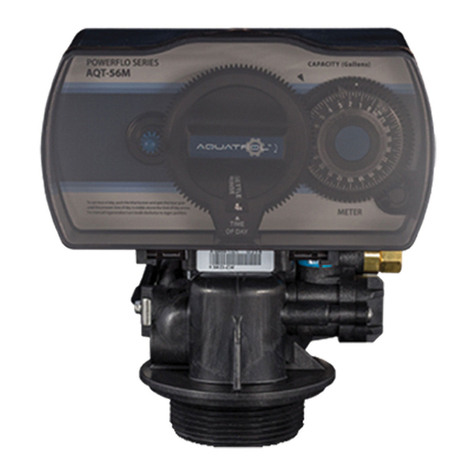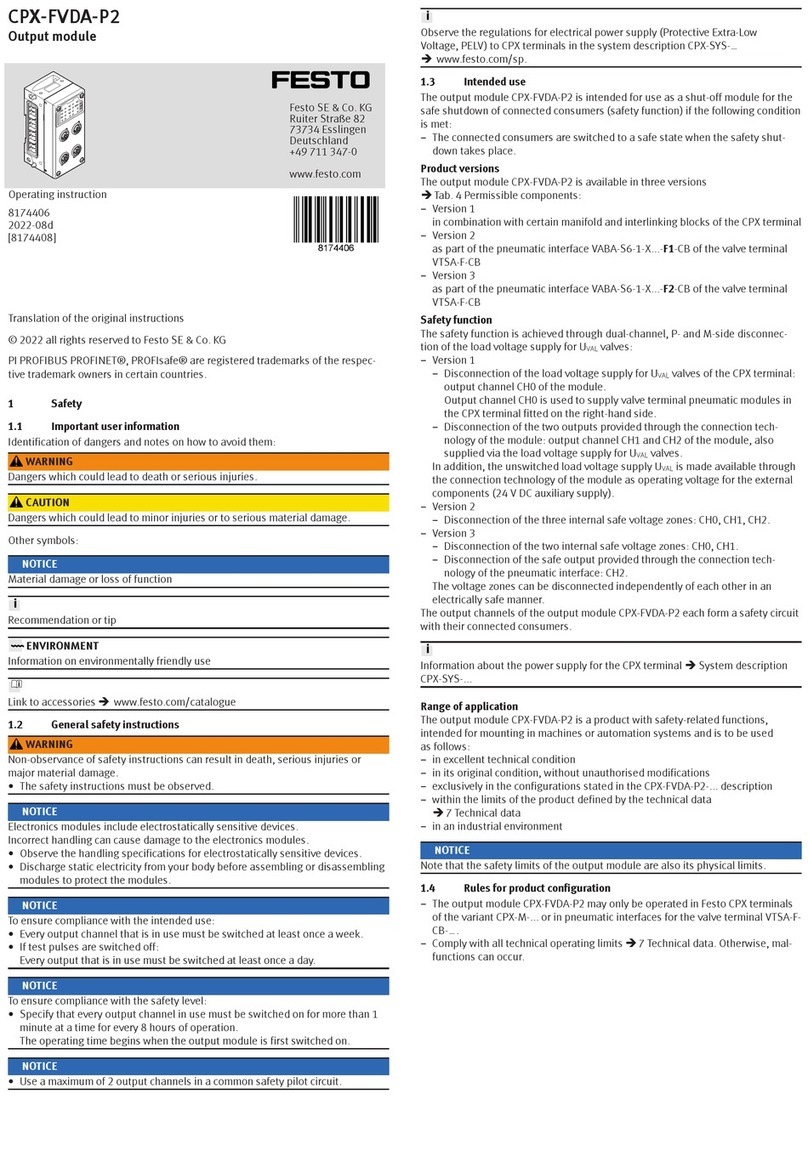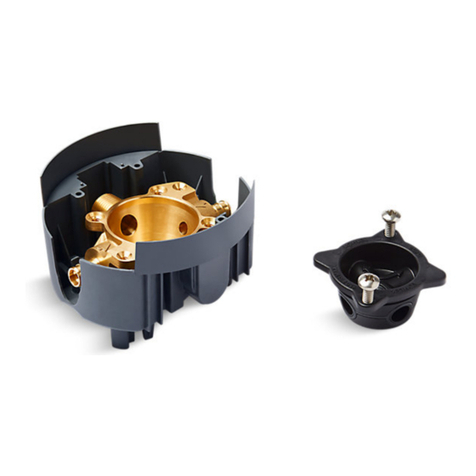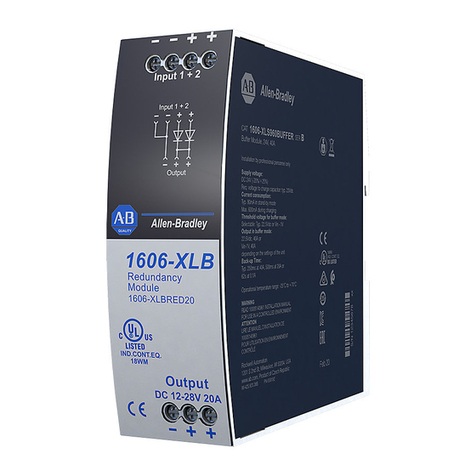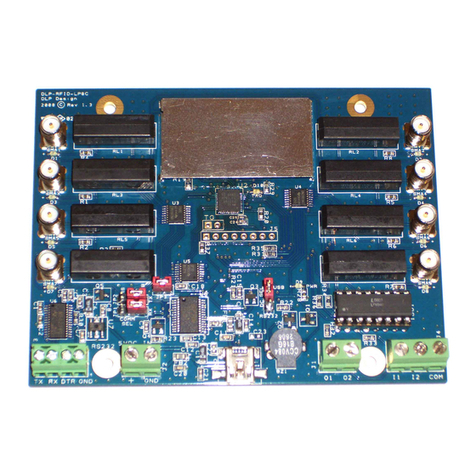DIGITAL DELAY REPLAY TACH User manual

1
2036 Fillmore Street
Davenport, Ia. 52804
563-324-1046
www.racedigitaldelay.com
REPLAY TACH
WITH RPM SWITCH
WARRANTY AND DISCLAIMER
DIGITAL DELAY ELECTRONICS INC. WARRANTS THE PRODUCTS IT
MANUFACTURES AGAINST DEFECTS IN MATERIALS AND WORKMANSHIP
FOR A PERIOD LIMITED TO 1 YEAR FROM THE DATE OF SHIPMENT,
PROVIDED THE PRODUCTS HAVE BEEN STORED, HANDLED, INSTALLED,
AND USED UNDER PROPER CONDITIONS.
The company’s liability under this limited warranty shall extend only to the
repair or replacement of a defective product, at the company’s option. DIGITAL DELAY
ELECTRONICS INC. AND DIGITAL DELAY INC. disclaims all liability for any
affirmation, promise, or representation with respect to the products.
The customer agrees to hold DIGITAL DELAY ELECTRONICS INC AND
DIGITAL DELAY INC. harmless from, defend, and indemnify DIGITAL DELAY
ELECTRONICS INC AND DIGITAL DELAY INC. against damages, claims, and
expenses arising out of subsequent sales of or use of DIGITAL DELAY ELECTRONICS
INC AND DIGITAL DELAY INC. products, or products containing components
manufactured by DIGITAL DELAY ELECTRONICS INC. and based upon personal
injuries, deaths, property damage, lost profits, and other matters which BUYER, its
employees, or sub-contractors are or may be to any extent liable, including without
limitation, penalties imposed by the Consumer Product Safety Act (P.L. 92-573) and
liability imposed upon any person pursuant to the Magnuson-Moss Warranty Act (P.L. 93-
637), as now in effect or as amended hereafter.
No warranties expressed or implied, are created with respect to the company’s
products except those expressly contained herein. The customer acknowledges the
disclaimers and limitations contained and relies on no other warranties or affirmations.

2
2036 Fillmore Street
Davenport, Ia. 52804
563-324-1046
www.racedigitaldelay.com
REPLAY TACH with RPM SWITCH Instructions
Digital Delay, the company that invented and patented the Crossover, designed and manufactured the Replay Tach
with RPM Switch especially for racers, who, due to rule changes lost the ability to shift or record using one of our other
products. In keeping with new rules, the Replay Tach with RPM Switch does not in any way connect to the transbrake circuit.
Digital Delay took the replay tach and the shift by RPM circuits from the mega 450, and then added some new features, built a
stand alone unit.
Getting Started
When the Replay Tach with RPM Switch is turned on, the Digital Delay logo screen is displayed for a couple seconds
while the unit goes through a power up routine. When done, the unit will go to the Shifts screen, which is the first of three
main level screens. Each of the three main level screens has at least one sub level screen. The sub level screens are where
changes to the unit’s settings can be made. While on the main level, (level one) use the menu button to cycle through the tree
main screens, or use the Change button to access the sub level screen of the current main level screen being displayed. When
in a sub level screen, use the menu button to cycle through the different screens on that level, use the arrow buttons to make
changes to the units settings, use the enter key to go to the next sub level, or use the back key to exit out of the sub levels back
to the main levels. All of the screens are listed on pages 4, 5, and 6 along with what each button will do for every screen.
After taking a little time to learn the screens, turning on the help screens will give a quick reminder of how to use
each screen.
Contents:
Warranty and Disclaimer............................….............................................…………….....Page 1
Features and Specifications...................................................................………….……….. Page 3
The Terminal Strip...............................................................………….....................………Page 3
The Three Main Screens
Shifts…………………………………………........................……..……………Page 4
Replay of Tach……………………………….........................……..……… ...... Page 4
Setup Modes………………………………............................……..……………Page 5
The Help Screens…………………. ............................……............………................……Page 6
The Data Lock……………………...............................…….........................………...……Page 6
Number of Cylinders……………………………………..............…...........………....……Page 6
Fall RPM, Reset RPM, and Shift Output Mode……………………….......………...……..Page 6
Testing the Shift Output…………………………………………………………………….Page 7
Understanding the Replay Tach…………………………………………………………….Page 7
Accessories………………………………...................……........….....…………........……Page 8
Mounting the Replay Tach with RPM Switch…………………............……….....………. Page 9
Wiring the Replay Tach with RPM Switch...................……..................………..........……Page 9

3
Features and Specifications
Features:
• Microprocessor controlled timing
• Discrete I/O (input - output) construction
• Retains all numbers even with power disconnected from unit
• 2 row 16 character illuminated LCD (liquid crystal display) for easy reading of information day or night
• Data Lock feature
• Variable speed replay tach
• Tach-out terminal
• Help Screens for every feature of unit
• Shift on RPM up to 5 times
• Works on 4, 6, and 8 cylinder engines
• Small rugged case
• Built-in Replay Tach with two record speeds
• Digital data port for down loading
•••••••••••••••••••••••••••••••••••••••••••••••••••••••••••••••••••••••••••••••••••••••••••••••••••••••••••••••••••••••••••••••••••••••••••••••••••••••••••••••••••
Specifications:
•Input Voltage Range: 10 to 18 Volts DC ( 16 Volt compatible )
•Operating Temperature Range: 0 to 150 degrees F.
•Push-button Current: .1 AMPS at 12 VDC
•Tach and RPM Switch Range: 800 to 12750 in 50 RPM increments
• Two Outputs
• Shift Output rated at 15 Amps.
• Tach output
• Two Inputs
• P.B. Record
• Tach
The Terminal Strip
Tach Terminal: Connect the Tach terminal to the tach output on the ignition.
Record Push-Button Terminal: To start a recording of a pass, connect to one wire of a push-
button with the other wire for the push-button going to +12Volts.
Tach-Out Terminal: Connect to the input on tachometer.
Ground Terminal: Connect the Ground terminal to the Neg. terminal on the battery or to a good steel ground,
not aluminum.
Shift Terminal: Connect the Shift terminal to the shifter solenoid. It is recommended that the wire going from
the REPLAY TACH with RPM SWITCH shift terminal to the shift solenoid be separated from all other wires to eliminate
cross talk between the wires. If all wires are bundled together undesirable results may occur.
+12VDC Terminal:Connect the +12VDC terminal to a switched +12 Volt.

4
The Three Main Screens
Shifts, Replay Tach, and Setup Modes
Shifts The screens are used to review and adjust the shift point settings.
__________________________________________________________________________________________
Level 1
While display shows (To view shifts press ENTER)
Menu button Moves to the Replay Tach screen
Change button Moves to the view shift screen
Back button N/A
Up Arrow N/A
Down Arrow N/A
-------------------------------------------------------------------------------------------------------------------------------
Level 2 While display shows (Shift X= XXXX)
Menu button Moves to next shift
Change button Moves to change shift point screen
Back button Moves back to the shift screen
Up Arrow N/A
Down Arrow N/A
-------------------------------------------------------------------------------------------------------------------------------
Level 2 While display shows (Change X= XXXX)
Menu button N/A
Change button N/A
Back button Moves back to the view shift screen
Up Arrow Increases shift point
Down Arrow Decreases shift point
Replay of Tach The Replay screen is used to review the last recorded pass.
__________________________________________________________________________________________
Level 1
While display shows (Press ENTER for replay of tach)
Menu button Moves to the setup modes screen
Change button Moves to the replay tach screen
Back button N/A
Up Arrow N/A
Down Arrow N/A
-------------------------------------------------------------------------------------------------------------------------------
Level 2 While display shows (Time RPM Shift)
Menu button Jumps to next shift point
Change button Stops the scrolling of the replay tach screen
Back button Moves back to the replay of tach screen
Up Arrow Scrolls up (repeatedly pressing increases / decreases scrolling speed)
Down Arrow Scrolls down (repeatedly pressing increases / decreases scrolling speed)
__________________________________________________________________________________________

5
Setup Modes The setup modes screens are used to adjust all settings not related to shift points.
__________________________________________________________________________________________
Level 1
While display shows ( Press ENTER to view setup modes )
Menu button Moves to the shifts screen
Change button Moves to the help screen
Exit button N/A
Up Arrow N/A
Down Arrow N/A
-------------------------------------------------------------------------------------------------------------------------------
Level 2 While display shows (help screens XXX)
Menu button Moves to pause RPM = XXXX.
Change button N/A
Exit button Moves back to the setup modes screen.
Up Arrow Toggles help on/off.
Down Arrow N/A
While display shows (Pause RPM = XXXX)
Menu button Moves to reset = XXXX.
Change button N/A
Exit button Moves back to the setup modes screen.
Up Arrow Adjust pause RPM (from reset RPM to 5000 RPM in 50 RPM increments)
Down Arrow N/A
While display shows (Reset RPM = XXXX)
Menu button Moves to fall RPM = XXXX.
Change button N/A
Exit button Moves back to the setup modes screen.
Up Arrow Adjust reset RPM (from 1500 RPM to 3000 RPM in 50 RPM increments)
Down Arrow N/A
While display shows (Fall RPM = 0XXX)
Menu button Moves to Cylinders = X.
Change button N/A
Exit button Moves back to the setup modes screen.
Up Arrow Adjust the fall RPM (from 50 to 200 RPM in 50 RPM increments).
Down Arrow N/A
While display shows (Cylinders = X)
Menu button Moves to data lock is XXX.
Change button N/A
Exit button Moves back to the setup modes screen.
Up Arrow Cycles through 4, 6, and 8 cylinder settings.
Down Arrow N/A
While display shows (Data lock is XXX)
Menu button Moves to record length = XX.
Change button N/A
Exit button Moves back to the setup modes screen.
Up Arrow Toggles data lock on/off.
Down Arrow N/A

6
While display shows (Record length XX)
Menu button Moves to shift output = XX.
Change button N/A
Exit button Moves back to the setup modes screen.
Up Arrow Sets record length to either 15 or 30 seconds.
Down Arrow N/A
While display shows (Shift output = XX)
Menu button Moves to help screens XXX.
Change button N/A
Exit button Moves back to the setup modes screen.
Up Arrow Toggles shift output HI/LO.
Down Arrow N/A
_____________________________________________________________________________________________________
The Help Screens
The help screens can be turned on and off in the setup modes screen. When turned on, every time a button is pressed
the Replay Tach with RPM Switch will cycle through three screens of text. Each of the three help screens will be displayed
for about 1 ½ second and will have a brief explanation of the current screen you have selected.
The Data Lock
The data lock can be turned on and off in the setup modes screen or by holding down the menu button until the data
lock screen is displayed. When turned on, with the exception of the data lock setting (none of the settings in the Replay Tach
with RPM Switch can be changed). This is to keep the settings in the unit from getting changed by accidentally hitting the
buttons.
Number of Cylinders
The Number of Cylinders is set under the setup modes screen and can be set to 4, 6, or 8 cylinders. This setting must
match the number of cylinders the engine has for proper operation.
Fall RPM, Reset RPM,
and Shift Output Mode
The Replay Tach with RPM Switch can handle up to five shifts on each pass. The five shifts can each be set to a
different RPM shift point. The shifts occur in sequence 1 through 5, once the engine RPM is higher than the reset RPM
setting. The reset RPM setting and the fall RPM are found in the Setup Mode screens, while the shift points can be viewed and
adjusted in the Shifts screens.
The Fall RPM is changed under the setup modes screen and can be set to 50, 100, 150, or 200 RPM. The fall RPM is
used to control how far the engine must fall below a shift point to complete the shift. In most cases the 50 RPM setting will
work the best, however in some vehicles that are shifting more than once this value may need to be increased to keep the
shifter from double cycling.
The Reset RPM is changed under the setup modes screen and can be set from 1500 RPM to 3000 RPM in 50 RPM
increments. When the engine RPM is below the reset RPM the shifting circuit is turned off and the pushbuttons on the Replay
Tach with RPM Switch are enabled. Also the shift sequence is reset to shift number one. When the engine RPM then rises
above the reset RPM the Replay Tach with RPM Switch buttons are disabled and the shift circuit is turned on and starts
looking for the first shift. When the engine RPM reaches the first shift point the shift terminal will activate and stay activated
until the engine RPM falls below the shift point minus, the fall RPM the unit will then start looking for the next shift. In the
event the next shift point is lower than the previous shift point minus the fall RPM, the engine will have to fall below the new
shift point before the unit will start looking for the new shift point.

7
For example if the first shift is at 6900 and the second is at 6400, after the first shift the engine must fall below 6350 for the
unit to look for the second shift.
The Shift Output setting corresponds to the operation of Shift terminal on the Replay Tach with RPM Switch and can
only be changed under the setup screen Shift Output. When the Shift Output is set to “HI” (normally open) it means every
time a Shift Point is reached the Shift terminal will go from a low (0 Volts) to a high (12 Volts). When the Shift Output is set
to “LO” (normally closed) it means that every time a Shift Point is reached the Shift terminal will go from a high (12 Volts) to
a low (0 Volts).
Testing the Shift Output
First test the Shift terminal for output. The easiest way to test the shift output, is to toggle the Shift Output mode
(explained above) between the HI and LO settings. Each time the Shift Output mode changes states the shifter should also
move. If the shifter does not move disconnect all wires connected to the Shift terminal. Then using a Digital Volt Meter or a
test light check the Shift terminal, it should have 12 Volts when the Shift Output Mode is set to LO and zero volts when the
Shift Output Mode is set to HI.
Understanding the Replay Tach
Note: The Replay Screen can only be viewed with the engine off.
The Replay Tach with RPM Switch has a built-in replay tach that has two record speeds. The record length can be set
to either 15 seconds or 30 seconds, the record length setting is in the setup modes screen. In the 15 or 30 second record mode
the recording starts as soon as the push button connected to the record terminal is released. In the 30 second record mode the
engine RPM is recorded every two hundredth of a second for thirty seconds. In the 15 second record mode the engine RPM is
recorded every hundredth of a second for fifteen seconds after the record Pushbutton is releases and the engine RPM rises
above the pause RPM setting. Keeping in line with the rules for both NHRA and IHRA where there can be no direct or
indirect connection between the ignition and the transbrake, Digital Delay had to remove the ability of the replay tach to start
with the release of the transbrake. This led to another problem, of the driver trying to release the record button as close to the
release of the transbrake as possible to ensure that the entire pass would be recorded in the allotted 15 seconds. The pause
RPM is used to compensate for this, by repeatedly overwriting the first stored value until the pause RPM is reached. Once the
pause RPM is reached the unit stops overwriting the first memory location and will continue recording the rest of the pass
normally. While the recording is no longer synchronized with the release of the transbrake, by using the pause RPM the first
stored value will be close to the release of transbrake.
Note: If the engine RPM is below the reset RPM pressing the menu button will cancel the recording.
To replay a previously recorded pass the engine must be turned off. Only then will the Replay Tach with RPM switch
allow access to the replay screen. Use the Up Arrow key to scroll the time up and the Down Arrow key to scroll the time
down. There are four scrolling speeds in each direction with the scrolling stopped in the middle. Each time an Arrow key is
pressed and released the scrolling speed will speed up. If while the time is scrolling and the opposite Arrow key is pressed and
released the scrolling speed will slow down. For example if the Up Arrow key was pressed three times to get a faster scrolling
speed, pressing the Down Arrow key once would cause the scrolling speed to slow down. Pressing the Down arrow an
additional two times would cause the scrolling to stop. If the Down Arrow were then pressed again the time would start
scrolling down.
The Change button is used to stop the scrolling of the replay tach regardless the scrolling speed. If in the previously
recorded pass there was at least one shift, pressing the menu button will cause the unit to jump directly to the shift point and
display the time and RPM the shift occurred. If more than one shift point was recorded pressing the menu button again will
cause the unit to jump to the next shift point.
During a replay of a pass with a standard electric automotive tachometer connected to the tach-out terminal on the
Replay Tach with RPM switch, the external tach will also show the recorded engine RPM.
The Replay Tach with RPM switch also has a Digital Data port located on the side of the unit opposite the terminal
strip. This Digital Data port is used to download a recorded pass to a hand-held unit called a Digital Viewer (Part # 1025-DV).
Once the recorded pass has been downloaded it can be viewed on the screens of the Digital Viewer or printed out on an IBM
compatible DOT matrix printer. When a recorded pass is printed, there will be a line showing shift points for the pass that was
recorded at the top of the paper. A sample print-out of a recorded pass is shown on the next page along with a drawing of the
Digital Viewer.

8
Accessories
Shown smaller then actual size

9
Mounting the Replay Tach with RPM Switch
For complete viewing of the LCD, care should be taken when mounting the unit to make sure that the display is
angled towards the driver’s eyes. Before mounting the Replay Tach with RPM Switch, place the box in the desired location
and check the legibility of the display in both day and night conditions. As shown below, the lower the box is placed below
eye level, the more the angle amount needs to increase for viewing.
Wiring the Replay Tach with RPM Switch
Connect to the Tach output of the Ignition box.
Connect to Push-button
Connect one wire of button to +12 volts, the other wire here.
Connect to optional an standard automotive electric tach.
Tach
Record
Tach Out
Ground
Shift
+12V
Connect the shift solenoid here.
Use of a 15 Amp inline fuse is recommended
Connect to battery or steel ground, Not Aluminum.
Connect to a switched +12 Volts.
Dri
ver
D
as
h
Box
Dri
ver
D
as
h
Box
Table of contents
Other DIGITAL DELAY Control Unit manuals


